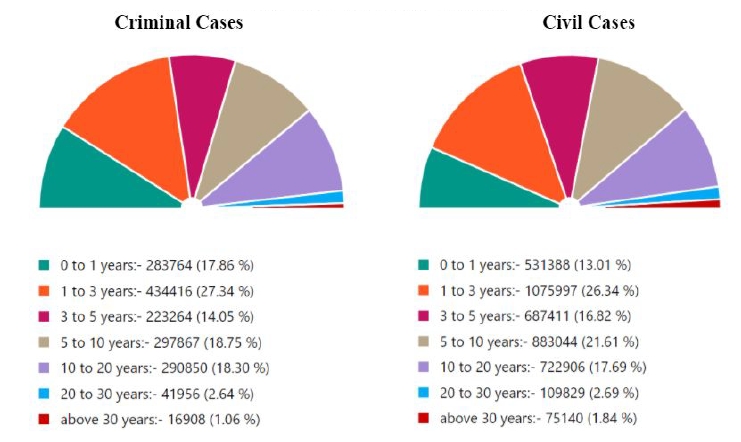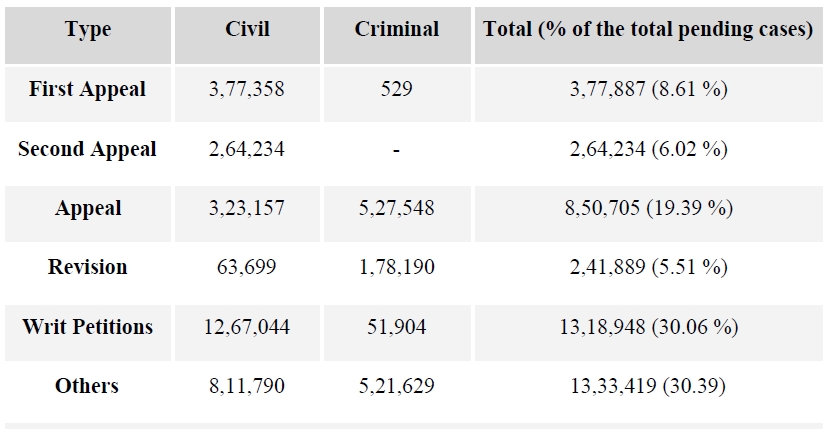High Courts, along with the Supreme Court, are the Constitutional Courts in India. They are constituted by, and derive authority directly from, the Constitution of India. High Courts are placed at the apex of the judicial pyramid in a state, and as such are entrusted with multiple responsibilities and an expansive jurisdiction, both original and appellate, over the territories over which their jurisdiction extends.
The Indian High Courts are facing a crisis of a great magnitude by virtue of their exploding dockets. The mounting arrears in these courts have only been worsening over the years, and is one of the greatest challenges to the judiciary today. Currently, there are over 5.6 million cases pending in the 25 High Courts across the country. About 20 per cent of these cases have been pending for more than a decade.
In addition to the pendency, the High Courts are also faced with a high vacancy in judicial strength. There are only 673 High Court judges currently, which means there are over 8,000 cases pending per judge in the High Courts. The unnaturally high caseload places undue pressure on the judges to dispose of cases at a faster rate, which will invariably affect the quality of adjudication. In fact, the disposal rate per judge in 2019 was an astonishing 3,500 cases!

Pie-Chart: Age-wise pendency in the High Courts.
Source: National Judicial Data Grid, 9 February 2021
These courts are meant to be the sentinels of our Constitution, ensuring the protection of citizens liberties as well as dispensing effective civil and criminal justice delivery. Although entrusted with the authority to adjudicate on matters of constitutional importance, these courts are currently unduly burdened with appellate and revisional matters which account for 40 per cent of their caseload. The High Courts are also entrusted with supervision and administrative control of trial courts under Article 235, and such a heavy caseload and vast responsibilities mean that the High Court justices in India are probably the most overworked judges in the world.

Table: Nature of Pending Cases in High Courts
Source: National Judicial Data Grid, 10 February 2021
It is therefore critical that the functioning of the High Courts is immediately strengthened, the means for which have been enumerated in the past by several expert bodies. Broadly, four approaches, which are complementary to each other, need to be adopted.
1. Filling up vacancies in sanctioned strength of judges
The Indian High Courts are currently functioning at 60 per cent capacity, with the rest of the positions being vacant. This only exacerbates the burden on the dockets of each individual judge. These positions must be filled up on priority across the country.
2. Appointment of ad hoc judges under Article 224A of the Constitution
Article 224A of the Constitution provides for the appointment of retired High Court judges for the purpose of clearing the arrears in the High Court docket. This provision must be invoked at the earliest to appoint an adequate number of such judges in order to clear the existing arrears in cases, as was previously recommended in the 79th Report of the Law Commission of India (LCI).
 |
3. Expanding the Judicial Clerk system
In all major democracies, judges of the constitutional courts have a great support system in the form of intelligent, knowledgeable, highly motivated judicial clerks. Many of the judicial clerks grow in stature over time and become leading lawyers and judges themselves. In India, the judicial clerk system is in its infancy. Each Judge of the High Court should be allotted four judicial clerks carefully selected based purely on merit, hard work and motivation.
4. Limiting the jurisdiction of the High Court
|
i. Abolition of Ordinary Original Civil Jurisdiction of High Courts Although the original criminal jurisdiction of the High Courts was abolished decades ago, six of them continue to exercise original jurisdiction for civil matters (see Table 13). Several Committees in the past, including the Satish Chandra Committee and the Arrears Committee, have favoured the abolition of such ordinary civil jurisdiction. There is no reason as to why these particular High Courts must exercise ordinary civil jurisdiction that adds to the caseload of a High Court that is not meant to be a court of first instance for such matters. The conditions under which such jurisdiction was granted to these High Courts have long disappeared with the establishment of City Civil Courts in each of the Metropolitan Cities where these High Courts exercise such jurisdiction. Moreover, the Economic Survey 2017-18 depicted that the disposal of a civil case takes longer in the High Courts than it does in the corresponding trial courts, citing the examples of the High Courts of Bombay and Delhi. Therefore, in line with the recommendations of the Arrears Committee, the original civil jurisdiction of HCs should be abolished and unlimited pecuniary jurisdiction ought to be conferred upon the respective City Civil Courts. Simultaneously, as proposed by the Malimath Committee, 1989-90, the strength of the Judges in City Civil Courts should be suitably increased, requisite staff must be sanctioned, and a sufficient number of courtrooms made available. ii. Restriction of appeals As recommended by the 79th LCI Report and by the Arrears Committee, the District Courts can perform as the appellate courts for a lot more cases, by increasing the pecuniary limits (i.e. the quantum of money under dispute) of their jurisdiction. In turn, this will limit the scope of first appeals to High Courts. A review of such pecuniary limits every three years must also be mandated, to keep raising this threshold. The pecuniary limit up to which no second appeal shall be entertained must also be enhanced in keeping with current requirements. Furthermore, such a bar must be made applicable irrespective of the nature of the suit as recommended by the Arrears Committee. iii. Revisional Jurisdiction The 54th LCI Report recommended the abolition of the civil revisional jurisdiction of the High Courts, and this must be implemented. The Law Commission opined that the High Courts' jurisdiction under Article 227 of the Constitution provides sufficient remedy in lieu of S.115 of the CPC. With respect to the criminal revision jurisdiction (S.397 of the CrPC), in line with the recommendations of the Arrears Committee, the High Court should have power of revision only against the orders of Sessions Courts/Special Courts, which are themselves not orders made under revisional jurisdiction. Sessions Courts should have exclusive power of revision against orders of criminal courts subordinate thereto. |























